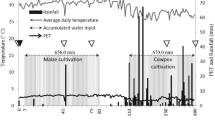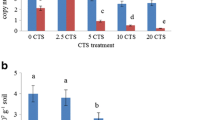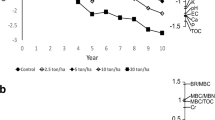Abstract
Composting has been recognised an alternative method to tannery sludge recycling and afterwards to be used in agriculture. As the tannery sludge contains salts and chromium, the application of composted tannery sludge (CTS) should be performed carefully to minimise negative effects on soil microbial properties. Therefore, this study evaluated the effects of 5-year repeated CTS amendment on soil microbial biomass (SMB) and enzyme activities in a tropical soil. CTS was applied during 5 years at 0, 2.5, 5, 10 and 20 Mg ha−1, and at the fifth year, the microbial biomass C (MBC) and N (MBN), basal and substrate-induced respiration (SIR), metabolic quotient (qCO2) and dehydrogenase (DHA) and fluorescein diacetate (FDA) hydrolysis were determined in the soil samples. Soil MBC and MBN showed the highest values with the amendment of 5 Mg ha−1 CTS. Soil respiration increased with the increase in CTS rates, while SIR showed the highest values with the amendment of 0, 2.5 and 5 Mg ha−1 CTS. DHA activity showed the highest values with the amendment up to 2.5 Mg ha−1, while FDA hydrolysis increased up to the rate of 5 Mg ha−1 CTS. The results show that after 5 years of permanent amendment of CTS, soils amended with 2.5 Mg ha−1 have SMB and enzymatic activities similar to those in unamended soil.

Similar content being viewed by others
References
Alef, K., & Nannipieri, P. (1995). Methods in soil microbiology and biochemistry. New York: Academic.
APHA. (2005). Standard methods for the examination for water and wastewater. Washington: American Public Health Association. 1600 pp.
Araújo, A. S. F., & Monteiro, R. T. R. (2006). Microbial biomass and activity in a Brazilian soil plus untreated and composted textile sludge. Chemosphere, 64, 1043–1046.
Araújo, A. S. F., Monteiro, R. T. R., & Carvalho, E. M. S. (2007). Effect of textile sludge composted on growth, nodulation and nitrogen fixation of soybean and cowpea. Bioresource Technology, 98, 1028–1032.
Araujo, A. S. F., Cesarz, S., Leite, L. F. C., Borges, C. D., Tsai, S. M., & Eisenhauer, N. (2013a). Soil microbial properties and temporal stability in degraded and restored lands of Northeast Brazil. Soil Biology & Biochemistry, 66, 175–181.
Araujo, A. S. F., Silva, M. D. M., Leite, L. F. C., Araujo, F. F., & Dias, N. S. (2013b). Soil pH, electric conductivity and organic matter after three years of consecutive applications of composted tannery sludge. African Journal of Agricultural Research, 8, 1204–1208.
Bremner, J. M. (1996). Nitrogen-total. In J. M. Bigham (Ed.), Methods of soil analysis, part 3 (pp. 1085–1121). Madison: Soil Science Society of America, American Society of Agronomy.
Brookes, P. C., Landman, A., Pruden, G., & Jenkinson, D. S. (1985). Chloroform fumigation and the release of soil nitrogen, a rapid direct extraction method to measure microbial biomass nitrogen in soil. Soil Biology & Biochemistry, 17, 837–842.
Casida, L. E., Klein, D. A., & Santoro, T. (1965). Soil dehydrogenase activity. Soil Science, 98, 371–376.
CICB (2013). Informações Econômicas. Centro das Indústrias de Curtume do Brasil. http://www.cicb.org.br/?p=10817. Accessed 20 October 2014.
CONAMA (2009). Define critérios e procedimentos para o uso de lodos de esgoto gerados em estações de tratamento de esgoto sanitário e seus produtos derivados. Resolução N° 375 Diário Oficial da União, DF, N° 167. p. 141–146. Conselho Nacional do Meio Ambiente (Conama), Brasília, Brazil.
Fernandes, S. A. P., Bettiol, W., & Cerri, C. C. (2005). Effect of sewage sludge on microbial biomass, basal respiration, metabolic quotient and soil enzymatic activity. Applied Soil Ecology, 30, 65–77.
Forster, J. C. (1995). Soil sampling and storage. In K. Alef & P. Nannipieri (Eds.), Methods in applied soil microbiology and biochemistry (p. 49). London: Academic.
Frankenberger, W. T., & Bingham, F. T. (1982). Influence of salinity on soil enzyme activities. Soil Science Society of American Journal, 46, 1173–1177.
García-Gil, J. C., Plaza, C., Soler-Rovira, P., & Polo, A. (2000). Long-term effects of municipal solid waste compost application on soil enzyme activities and microbial biomass. Soil Biology & Biochemistry, 32, 1907–1913.
Giacometti, C., Cavani, L., Gioacchini, P., Ciavatta, C., & Marzadori, C. (2012). Soil application of tannery land plaster, effects on nitrogen mineralization and soil biochemical properties. Applied Environmental Soil Science, 1, 1–9.
Gonçalves, I. C. R., Araujo, A. S. F., Nunes, L. A. P. L., & Melo, W. J. (2014). Soil microbial biomass after two years of consecutive application of composted tannery sludge. Acta Scientiarum Agronomy, 36, 35–41.
Kizilkaya, R., Askin, T., Bayrakli, B., & Saglam, M. (2004). Microbiological characteristics of soils contaminated with heavy metals. European Journal of Soil Biology, 40, 95–102.
Lavelle, P., & Spain, A. (2001). Soil ecology. Dordrecht: The Netherlands, Kluwer Academic Publishers.
Lopes, E. L. N., Fernandes, A. R., Ruivo, M. L. P., Cattanio, J. H., & Souza, G. F. (2011). Microbial biomass and soil chemical properties under different land use systems in northeastern Pará. Revista Brasileira de Ciência do Solo, 35, 1127–1139.
Martí, E., Sánchez, M., Sierra, J., Cruanas, R., & Garau, M. A. (2007). Ecotoxicological tests assessment of soils polluted by chromium (VI) and pentachlorophenol. Science of Total Environment, 378, 53–57.
Martines, A. M., Nogueira, M. A., Santos, C. A., Nakatani, A. S., Andrade, C. A., Coscione, A. R., Cantarella, H., Sousa, J. P., & Cardoso, E. J. B. N. (2010). Ammonia volatilization in soil treated with tannery sludge. Bioresource Technology, 101, 4690–4696.
Marzadori, C., Ciavatta, C., Montecchio, D., & Gessa, C. (1996). Effects of lead pollution on different soil enzyme activities. Biology & Fertility of Soils, 22, 53–58.
Nelson, D. W., & Sommers, L. E. (1996). Total carbon, organic carbon, and organic matter. In A. L. Page (Ed.), Methods of soil analysis, part 2 (2nd ed.). Madison: American Society of Agronomy.
Olcay, F., Şagban, T., Dindar, E., & Başkaya, H. S. (2013). Biostimulating effects of wastewater sludges on stressed soils. Journal of Biology and Environmental Science, 7, 153–161.
Patel, A., & Patra, D. D. (2014). Influence of heavy metal rich tannery sludge on soil enzymes vis-à-vis growth of Tagetes minuta, an essential oil bearing crop. Chemosphere, 112, 323–332.
Richards, L. A. (1954). Diagnosis improvements of saline and alkaline soils. Washington: Department of Agriculture. 160p.
Ros, M., Pascual, J. A., Garcia, C., Hernandez, M. T., & Insam, H. (2006). Hydrolase activities, microbial biomass and bacterial community in a soil after long-term amendment with different composts. Soil Biology & Biochemistry, 38, 3443–3452.
Santos, J. A., Nunes, L. A. P. L., Melo, W. J., & Araujo, A. S. F. (2011). Tannery sludge compost amendment rates on soil microbial biomass of two different soils. European Journal of Soil Biology, 47, 146–151.
Scherer, H. W., Metker, D. J., & Welp, G. (2011). Effect of long-term organic amendments on chemical and microbial properties of a luvisol. Plant Soil Environment, 57, 513–518.
Schnurer, J., & Rosswall, T. (1982). Fluorescein diacetate hydrolysis as a measure of total microbial activity in soil and litter. Applied & Environmental Microbiology, 43, 1256–1261.
Silva, M. D. M., Barajas-Aceves, M., Araujo, A. S. F., Araujo, F. F., & Melo, W. J. (2014). Soil microbial biomass after three years of consecutive composted tannery sludge amendment. Pedosphere, 24, 469–475.
Singh, R. P., & Agrawal, M. (2007). Effects of sewage sludge amendment on heavy metal accumulation and consequent responses of Beta vulgaris plants. Chemosphere, 67, 2229–2240.
Stępniewska, Z., & Wolińska, A. (2005). Soil dehydrogenase activity in the presence of chromium (III) and (VI). International Agrophysics, 19, 79–83.
Svensson, K., & Friberg, H. (2007). Changes in active microbial biomass by earthworms and grass amendments in agricultural soil. Biology & Fertility of Soils, 44, 223–228.
Tedesco, M. J., Gianello, C., & Bissani, C. A. (1995). Analises de solos, plantas e outros materiais. Porto Alegre: UFRGS. 252p.
Tripathi, R. D., Srivastava, S., Mishra, S., Singh, N., Tuli, R., Gupta, D. K., & Maathuis, F. J. M. (2007). Arsenic hazards, strategies for tolerance and remediation by plants. Trends Biotechnology, 25, 158–165.
USEPA (1996). Acid digestion of sediments, sludge’s and soils. Method 3050b. Washington, EPA, 12p.
van der Heijden, M. G. A., Bardgett, R. D., & van Straalen, N. M. (2008). The unseen majority, soil microbes as drivers of plant diversity and productivity in terrestrial ecosystems. Ecology Letters, 11, 296–31.
Vance, E. D., Brookes, P. C., & Jenkinson, D. S. (1987). An extraction method for measuring soil microbial biomass C. Soil Biology & Biochemistry, 19, 703–707.
Wyszkowska, J., Kucharski, J., Jastrzębska, E., & Hlasko, A. (2001). The biological properties of soil as influenced by chromium contamination. Polish Journal of Environmental Studies, 10, 37–42.
Yeomans, J. C., & Bremner, J. M. (1988). A rapid and precise method for routine determination of organic carbon in soil. Communication in Soil Science and Plant Analysis, 19, 1467–1476.
Zimmermann, S., & Frey, B. (2002). Soil respiration and microbial properties in an acid forest soil, effects of wood ash. Soil Biology & Biochemistry, 34, 1727–1737.
Acknowledgments
This research was funded by “Conselho Nacional de Desenvolvimento Científico e Tecnológico” (CNPq-Brazil) and “Coordenação de Aperfeiçoamento de Pessoal de Nivel Superior” (CAPES). A.S.F Araújo and W.J. Melo are supported by a personal grant from CNPq-Brazil.
Author information
Authors and Affiliations
Corresponding author
Rights and permissions
About this article
Cite this article
Araujo, A.S.F., Miranda, A.R.L., Oliveira, M.L.J. et al. Soil microbial properties after 5 years of consecutive amendment with composted tannery sludge. Environ Monit Assess 187, 4153 (2015). https://doi.org/10.1007/s10661-014-4153-3
Received:
Accepted:
Published:
DOI: https://doi.org/10.1007/s10661-014-4153-3




